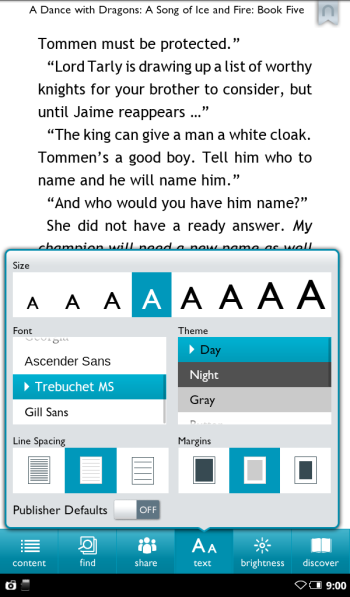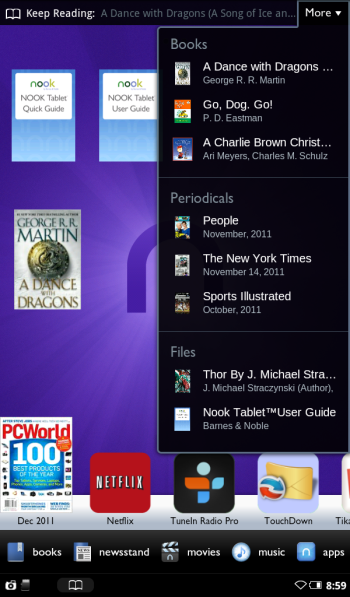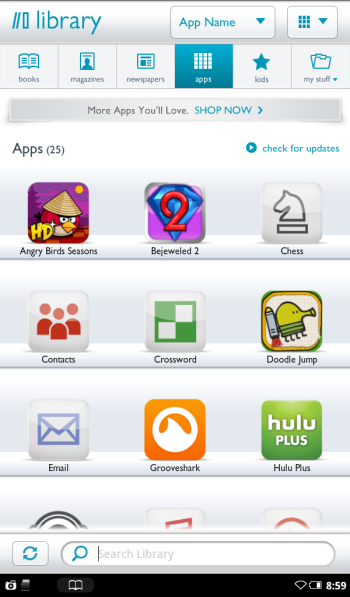B&N's Nook Tablet has beefier specs than Amazon's Kindle Fire, but it also has its share of limitations as a tablet.
The $250 Barnes & Noble Nook Tablet, available starting on November 16, will provide solid competition for Amazon's Kindle Fire. This is Barnes & Noble's second-generation device, a follow-on to last year's Nook Color, which now drops to $200, the same price as the Kindle Fire.
Now that I've had a chance to use the Nook Tablet, I've been able to identify some of its strengths, and a few of its weaknesses. Here are my initial impressions, particularly in comparison with the Kindle Fire. (This piece will be updated when we complete our full review.)
The Nook Tablet's main weakness--like the Kindle Fire's---is that it isn't a full-featured tablet. It lacks components such as built-in Bluetooth, stereo speakers, GPS, and front- and rear-facing cameras, most of which are common elements of tablets today. It also doesn't possess some common tablet capabilities, such as navigating primary tablet screens (for example, the home screen and content libraries) in landscape mode. Another omission: You can't view folders of images and movies in the included image gallery--all of the media thumbnails end up in one big bucket.
Still, the Nook Tablet's low price will make it appealing to fans of both e-readers and tablets. In fact, it's priced low enough to sway some consumers who might have been considering an iPad 2, which has a larger display, but also costs twice as much. Considering the Nook Tablet's competitive price and beefy specs, makers of other so-called "value" tablets (including Amazon, with its Kindle Fire tablet) may find that it poses a serious challenge.
And though the Nook Tablet doesn't excel as a tablet, it stays true to its roots as an LCD e-reader that is optimized for reading. That's one area where Amazon's Kindle Fire may have tripped up. The Nook Tablet's unique display has less reflectivity than the Kindle Fire's, and so is easier to read. In addition, some fonts and videos render more sharply on it than on the Fire.
Impressive Specs
This tablet's beefed-up horsepower--in comparison to the earlier Nook Color e-reader's--really counts. The dual-core 1GHz Texas Instruments OMAP 4 CPU and 1GB of RAM made switching from app to app a breeze, with little lag or stuttering. Movies played smoothly and stutter-free in Netflix, and the high-definition images re-rendered for Nook's 1024-by-600-pixel display looked lovely, with terrific contrast.
The Nook Tablet's display was dazzling overall. It's basically the same as the one on the Nook Color; but Barnes & Noble says that the new display incorporates some improvements from the company's display supplier.
Those improvements--and not software enhancements--account for the Nook Tablet's superior handling of whites and browns. In a test image, for example, skin tones and a brown sweater looked far more realistic on the Nook Tablet than on the Nook Color.
The screen's glare was minimal, thanks to what Barnes & Noble calls its VividView display. The IPS display is laminated and bonded; so unlike on other tablets's displays--including the Kindle Fire's--there's no annoying, visible air gap between the glass screen and the LCD beneath.
That's not to say that glare has completely disappeared on the Nook Tablet, but the difference is obvious in a side-by-side comparison. The VividView display also enhances the contrast and viewing angle of the Nook Tablet versus the Kindle Fire. The tablet felt noticeably lighter than the Nook Color, even though the difference on paper--1.7 ounces--seem negligible. Still, I could feel the difference when holding the tablet in one hand, as I often do when using one.
Side-by-side with the Kindle Fire, the weight difference is less evident. Only hundredths of a pound separate the two, and their balance feels quite different because of their different dimensions (the Nook Tablet is about 0.67 inch taller than the Kindle Fire).
Navigating the Nook Tablet
With the original Nook Color, Barnes & Noble's operating system--a variant initially built on the Android 2.2 OS--evolved in keeping with the Nook Tablet's alignment into the bigger tablet universe.
The Nook Tablet takes that integration to a higher level, but only for some apps. At launch, the flagship example is Netflix, whose tablet-optimized app and options are accessible from the Nook Tablet's home screen. You can access your Netflix viewing history and recommendations from the home screen and from the home screen's More menu--a convenient and logical move, given the Nook Tablet's aim to embrace its full tablet potential from the get-go, and given that Barnes & Noble lacks the direct digital storefront tie-ins that Amazon's Kindle Fire offers.
As a whole, apps are now treated in much the same way as book and periodical content. You can reach all of them through the recently accessed bar along the bottom of the home screen, and you can pin any of them to the home screen for easy one-tap access. I appreciated that this area didn't get cluttered with specific, recently played video or music selections--as happens on the Kindle Fire.
For all of its expansion to embrace apps and multimedia, the Nook Tablet continues to be optimized for reading, as is clear from the display, from how you access books, and from tablet's the visual presentation of periodicals.
The new Read and Record feature in children's books is especially compelling; it worked very well when I tried it. I could create my own audio track to accompany a book, a feature with special appeal for families with a loved one who travels or is far away. I hope we'll see the mic incorporated into other applications. Regrettably, video chat won't be one of those applications, since B&N didn't include a front-facing camera.
Where Are the Apps?
Apps are the lifeblood of any tablet--as can be seen from the thriving 100,000+ strong app ecosystem for the Apple iPad. Android tablets have struggled, though, in part because of the fragmentation caused by different Android OS versions and different screen sizes. Among competing, full-blown 7-inch tablets, the latest models from Acer, Samsung, Toshiba, and leading tablet makers use Google's Android 3.2 Honeycomb operating system, which was optimized for the larger screen sizes of tablets. Other models--particularly those produced by budget-conscious tablet makers--use some version of Android 2.2 or Android 2.3, neither of which was intended for use on tablets. In either case, finding apps that fit the tablet screen and look appropriate on a tablet has been an ongoing issue for Android tablets in general.
Barnes & Noble based the Nook Tablet OS on Android 2.3, but the company doesn't include support for Android Market. Instead, apps are funneled through B&N's own, growing app store.
But there is some advantage to consumers in B&N's curated approach. In practice, the contrast to the messy Android Market experience was quite refreshing. I've downloaded plenty of apps from the Android Market onto 7-inch tablets only to have them crash and force-close on me--or not stretch properly to fit the tablet's screen. It was also a pleasant switch from what I saw in the Kindle Fire's Amazon Appstore.
What Barnes & Noble Missed
The Nook Tablet is missing such common tablet features as Bluetooth, stereo speakers, a GPS, and front- and rear-facing cameras. The Nook Color omitted those features as well, but considering that the Nook Tablet calls itself a tablet and is trying to compete with tablets, Barnes & Noble should have added at least some of them.
Admittedly, some of the "value" competition lacks Google services and cameras, too; but the Nook Tablet's core specs are good enough for it to play in the big kids' sandbox, alongside 7-inch Android Honeycomb tablets from the likes of Samsung and Toshiba.
The Nook Tablet would stand up better to the competition if it had added a more competitive feature set.
I would also like to have seen B&N step up the display's resolution. B&N's bonded and laminated VividView display qualities significantly improve the display's quality, but in some fonts, I could still see pixelation in the text.
I prefer the smooth text rendering of higher-resolution displays, such as those offered by Toshiba's 7” Thrive and T-Mobile's SpringBoard, two Android 3.2 Honeycomb tablets that have raised their display resolution to 1280 by 800 pixels. And even Samsung's Galaxy Tab 7.0 Plus--another Honeycomb tablet, but one that has the same resolution as the Nook Tablet--does a better job of text rendering than the Nook Tablet.
Though B&N clearly missed a few opportunities to forge ahead of the 7-inch tablet pack, these omissions were undoubtedly carefully calculated trade-offs necessitated by the need to achieve an attractive price. And attractive it is: At $250, the Nook Tablet is a bargain compared with theSamsung Galaxy Tab 7 Plus (shipping now) and the Thrive 7” (shipping in December), both priced at $399. It's also far cheaper than the SpringBoard ($440 across its two-year contract, plus monthly mobile broadband payments).
As for how the Nook Tablet tracks with the Kindle Fire, here's our first take: For reading, you're better off with the Nook Tablet. For everything else, check back soon to read our full evaluation of the Nook Tablet, and to see where it fits into the current tablet landscape.




.gif)
.gif)









0 Responses So Far: